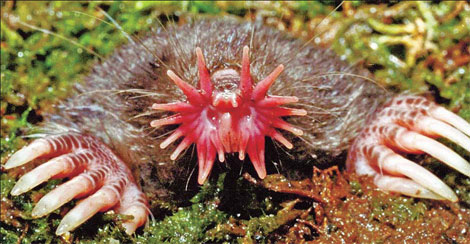Our fellow creatures, filling us with disgust
There are some animals that are, by our standards, ugly.
Now, a few researchers are attempting to understand why we find certain animals unsightly even when they don't threaten us with venom or compete for our food.
 |
|
Researchers are trying to learn why humans find some other animals, like the star-nosed mole, so unappealing. Kenneth Catania/EPA |
Among the all-star uglies are the star-nosed mole, whose face, said Nancy Kanwisher, a neuroscientist at the Massachusetts Institute of Technology, "is disturbing because it looks like the animal has no face." The blobfish, by contrast, is practically all face - a pale, gelatinous deep-sea creature whose large-lipped, sad expression seems to be melting.
"It looks like if you handled it," said Geoffrey Miller, an evolutionary psychologist at the University of New Mexico, "at the very least you'd get some kind of rash."
As scientists see it, a comparative consideration of what we find freakish or unsettling in other species offers a fresh perspective on how we extract large amounts of visual information from a glance, and then anthropomorphize that assessment into a revealing saga of ourselves.
"No one would find the star-nosed mole ugly if its star were iridescent blue," said Denis Dutton, professor of the philosophy of art at the University of Canterbury in New Zealand. "But the resemblance of the pinkish nose to human flesh subverts our expectations and becomes a perverse violation of whatever values we have about what constitutes normal or healthy human skin."
We have the male proboscis monkey and the male elephant seal, with their pendulous, vaguely salacious noses, and the woolly bat and the vampire bat, their squashed snub noses accentuating their razor-toothed gapes. The warthog's trapezoidal skull is straight out of Picasso's "Guernica," while in the warthog's kin, the babirusa, one of its two pairs of curving tusks will grow up and around and pierce its skull.
And of our own creation are the purebred cats and dogs that are stump-limbed, hairless and wrinkled, with buggy eyes and concave snouts, and ears as big as a jackrabbit's. We love them, not in spite of their ugliness, but because of it.
Conservation researchers argue that only by being aware of our aesthetic prejudices can we set them aside when deciding which species cry out to be studied and saved. Reporting recently in the journal Conservation Biology, Morgan J. Trimble, a research fellow at the University of Pretoria in South Africa, and her colleagues uncovered evidence that scientists, like the rest of us, may be biased toward the beautiful.
Assessing the publication database of scientific literature for the years 1994 through 2008, the researchers found 1,855 papers about chimpanzees, 1,241 on leopards and 562 about lions - but only 14 for the African manatee.
Speculating on a possible reason for the disparity, Ms. Trimble said, "Most scientists are in it for the love of what they do, and a lot of them are interested in big, furry cute things."
Or little cute things. Humans and other mammals seem to have an innate attraction to infant cues like large, wide-set eyes, a button nose and a mouth set low in the face, and the universality of these cues explains why mother dogs have been known to nurse kittens, lionesses to take care of antelope kids.
On a first pass, then, "ugliness would be the deviation from these qualities," said David Perrett, an evolutionary psychologist at the University of St. Andrews in Scotland. A baby grows into a healthy, fertile youth, which in humans is visually characterized by clarity of shape and sleekness of form, said Wendy Steiner of the University of Pennsylvania. "An animal with saggy skin, whiskers and no neck will look like some old guy who's lost it," she joked.
The more readily we can analogize between a particular animal body part and our own, the more likely we are to cry ugly. "We may not find an elephant's trunk ugly because it's so remote," Dr. Dutton said. "But the proboscis on a proboscis monkey is close enough to our own that we apply human standards to it."
People are also keenly, even obsessively vigilant for signs of ill health in others. "That means anything that looks seriously asymmetrical when it should be symmetrical, that looks rough and irregular when it should be smooth, that looks like there might be parasites on the skin or worms under the skin, jaundice or pallor," Dr. Miller said.
We distinguish between the signs of an acquired illness and those of an innate abnormality. Splotches, bumps and greasy verdigris skin mean "possibly infectious illness," while asymmetry and exaggerated, stunted or incomplete features hint of a congenital problem.
"Deformities provide a lot of information about what can go wrong, and by contrast what good function is," Dr. Miller said. "This is not just about physical deformities. People who seem crazy are also highly attention-grabbing."
On the other hand, a taste for the difficult, the unconventional, the ugly has often been seen as a mark of sophistication, a passport into the rarefied world of the artistic vanguard.
"Beauty," Dr. Steiner said, "can be present by its violation."
 0
0 






